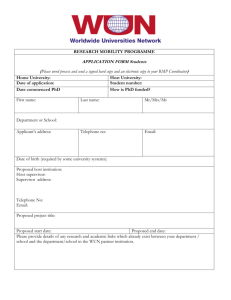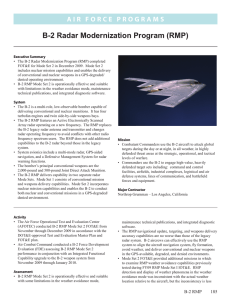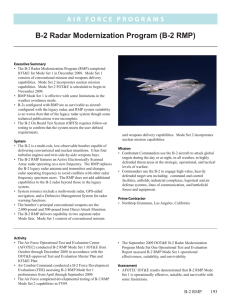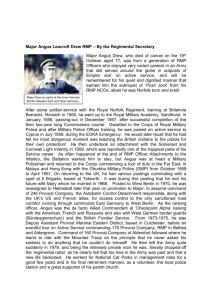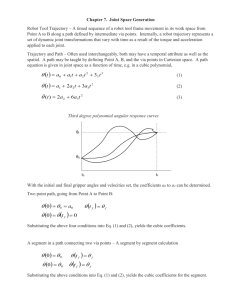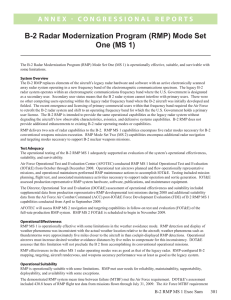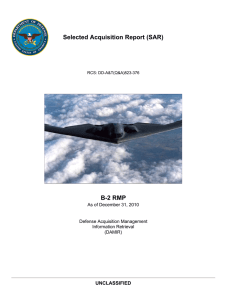B-2 Radar Modernization Program (B-2 RMP)
advertisement
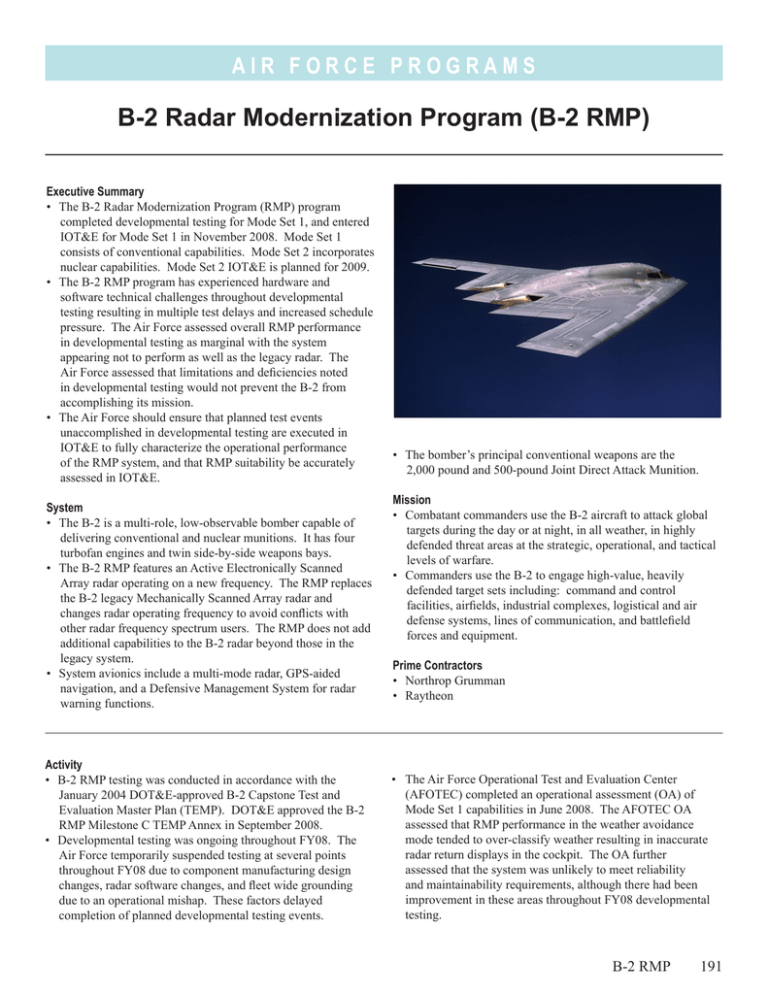
A i r F o r c e P RO G R A M S B-2 Radar Modernization Program (B-2 RMP) Executive Summary • The B-2 Radar Modernization Program (RMP) program completed developmental testing for Mode Set 1, and entered IOT&E for Mode Set 1 in November 2008. Mode Set 1 consists of conventional capabilities. Mode Set 2 incorporates nuclear capabilities. Mode Set 2 IOT&E is planned for 2009. • The B-2 RMP program has experienced hardware and software technical challenges throughout developmental testing resulting in multiple test delays and increased schedule pressure. The Air Force assessed overall RMP performance in developmental testing as marginal with the system appearing not to perform as well as the legacy radar. The Air Force assessed that limitations and deficiencies noted in developmental testing would not prevent the B-2 from accomplishing its mission. • The Air Force should ensure that planned test events unaccomplished in developmental testing are executed in IOT&E to fully characterize the operational performance of the RMP system, and that RMP suitability be accurately assessed in IOT&E. System • The B-2 is a multi-role, low-observable bomber capable of delivering conventional and nuclear munitions. It has four turbofan engines and twin side-by-side weapons bays. • The B-2 RMP features an Active Electronically Scanned Array radar operating on a new frequency. The RMP replaces the B-2 legacy Mechanically Scanned Array radar and changes radar operating frequency to avoid conflicts with other radar frequency spectrum users. The RMP does not add additional capabilities to the B-2 radar beyond those in the legacy system. • System avionics include a multi-mode radar, GPS-aided navigation, and a Defensive Management System for radar warning functions. Activity • B-2 RMP testing was conducted in accordance with the January 2004 DOT&E-approved B-2 Capstone Test and Evaluation Master Plan (TEMP). DOT&E approved the B-2 RMP Milestone C TEMP Annex in September 2008. • Developmental testing was ongoing throughout FY08. The Air Force temporarily suspended testing at several points throughout FY08 due to component manufacturing design changes, radar software changes, and fleet wide grounding due to an operational mishap. These factors delayed completion of planned developmental testing events. • The bomber’s principal conventional weapons are the 2,000 pound and 500-pound Joint Direct Attack Munition. Mission • Combatant commanders use the B-2 aircraft to attack global targets during the day or at night, in all weather, in highly defended threat areas at the strategic, operational, and tactical levels of warfare. • Commanders use the B-2 to engage high-value, heavily defended target sets including: command and control facilities, airfields, industrial complexes, logistical and air defense systems, lines of communication, and battlefield forces and equipment. Prime Contractors • Northrop Grumman • Raytheon • The Air Force Operational Test and Evaluation Center (AFOTEC) completed an operational assessment (OA) of Mode Set 1 capabilities in June 2008. The AFOTEC OA assessed that RMP performance in the weather avoidance mode tended to over-classify weather resulting in inaccurate radar return displays in the cockpit. The OA further assessed that the system was unlikely to meet reliability and maintainability requirements, although there had been improvement in these areas throughout FY08 developmental testing. B-2 RMP 191 A i r F o r c e P RO G R A M S • The program completed developmental testing in August 2008, and the Air Force assessed overall RMP performance as marginal with the system appearing not to perform as well as the legacy radar. The Air Force further assessed that limitations and deficiencies noted in developmental testing would not prevent the B-2 from accomplishing its mission. • The Air Force certified the RMP program ready for IOT&E, which began in November 2008. Assessment • The RMP program is largely schedule-driven due to a compulsory system fielding date. Testing delays due to design and manufacturing changes, radar software performance, and fleet-wide grounding precluded the program from completing all planned developmental testing events and missions within the available schedule. • DOT&E concurs with the AFOTEC OA and Air Force developmental testing assessments of RMP performance. Marginal performance in developmental testing increases program risk in achieving the user’s operational effectiveness, suitability, and mission capability metrics in IOT&E. 192 B-2 RMP • Due to the limited number of dedicated IOT&E flight hours and the numerous changes in configuration throughout developmental testing, it may be difficult to fully characterize system suitability using IOT&E data alone. Supplemental system suitability data from developmental testing may have to be included in the evaluation to accurately characterize RMP system suitability. Recommendations • Status of Previous Recommendations. There are no outstanding recommendations. • FY08 Recommendations. 1. The Air Force should ensure that planned test events unaccomplished in developmental testing be executed in IOT&E to fully characterize the operational performance of the RMP system. 2. The Air Force should ensure that RMP system suitability be accurately assessed in IOT&E and throughout subsequent Mode Set 2 FOT&E.
